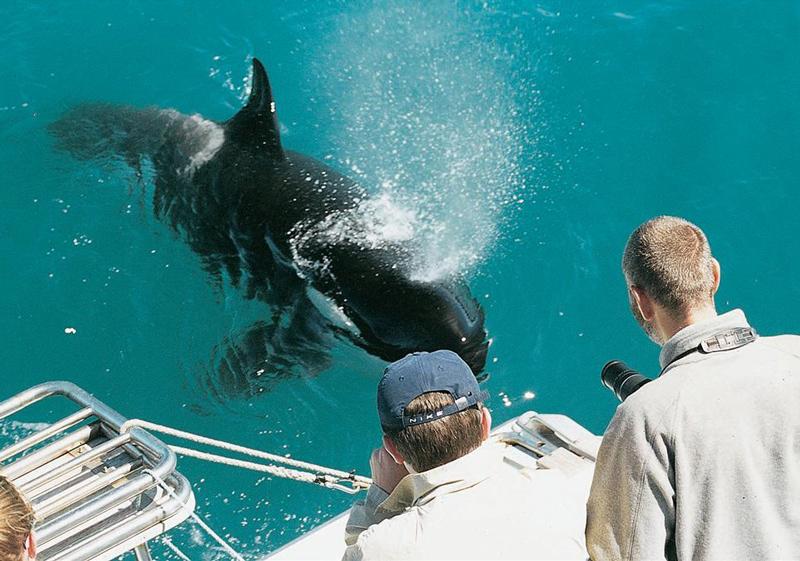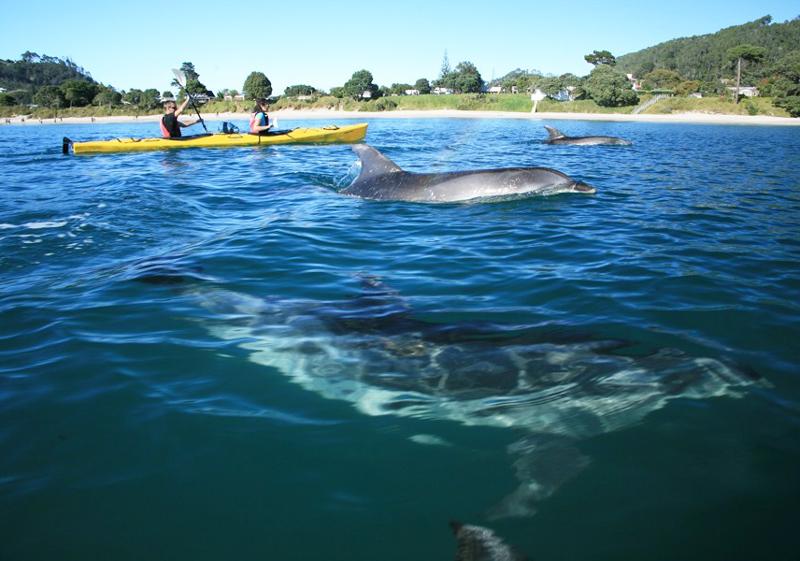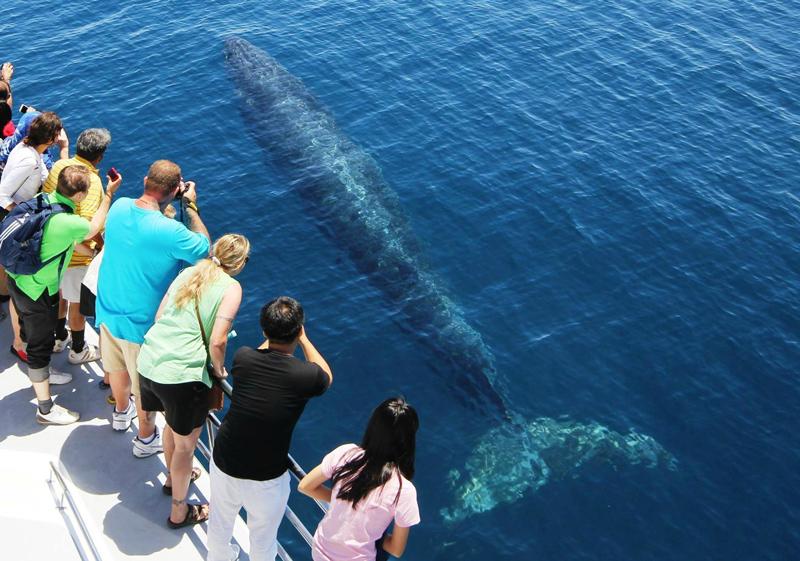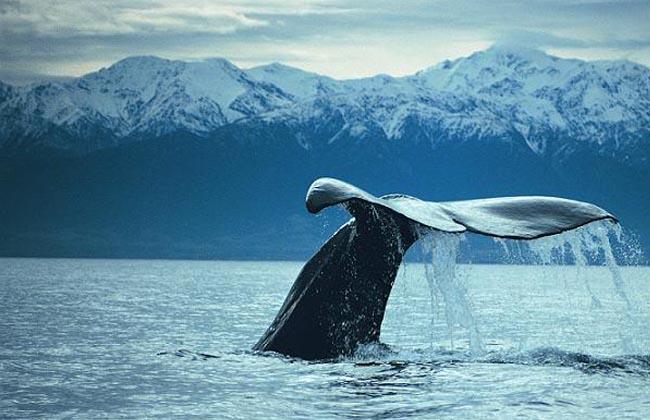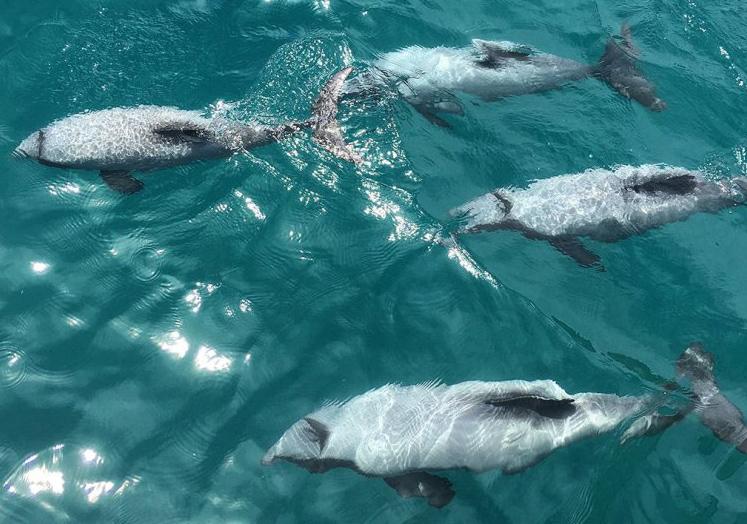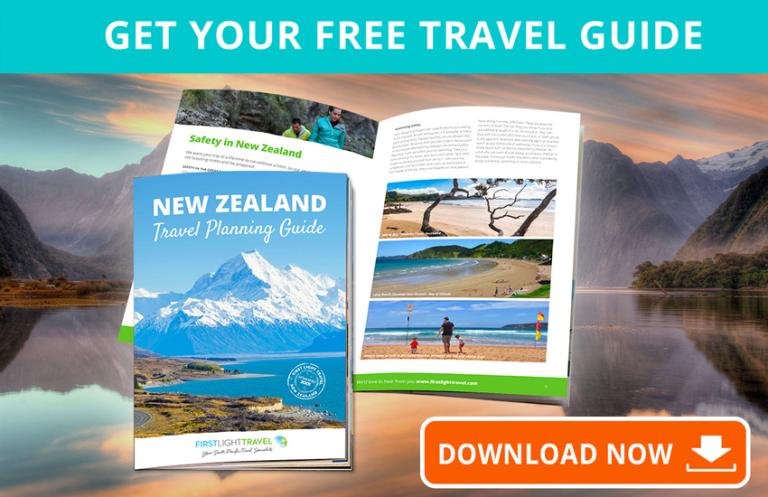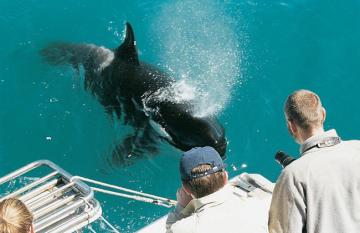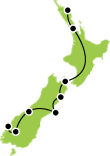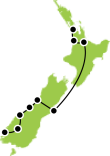
New Zealand is considered one of the cetacean (whales, dolphins and porpoises) watching hot-spots in the world. Given that at least 35 of the 80-odd different species can be found here, it is no wonder it has earned such a reputation.
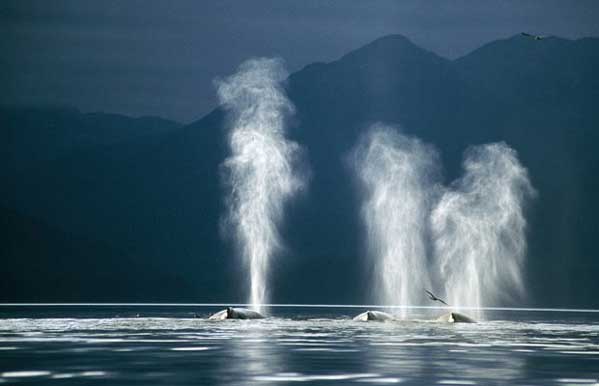
It is hard to say what it is about whales and dolphins that attract humans, but they certain have that ‘X’ factor. And if you have ever wanted to meet them in their own environment, here is your chance!
Sometimes whale watchers get lucky and catch a glimpse of the world’s largest animal – the blue whale. This whale is so large, its heart is the size of a Volkswagen ‘beetle’ car, and it’s tongue weighs the same as an elephant!
Orca
New Zealand also boasts the world’s largest dolphin – the orca, or killer whale, and one of the smallest – the Hector’s dolphin, found only around New Zealand. The orcas living around New Zealand have been found to be unique – they specialise in hunting for sharks and rays – and even speak their own recognisable dialect. The Hector’s dolphin is typically found in very close to shore and is considered one of the world’s rarest marine dolphins. It is so tiny you could hold one in your arms
Dolphins and Humpbacks
But there are other, more well-known species you can see, such as the humpback whale, (which migrates past New Zealand, on its way to and from Antarctica), the common dolphin (this is the dolphin which is depicted on Greek coins with a boy riding on it’s back), and the bottlenose dolphin (this is the same sort of dolphin as “Flipper”). The common dolphin is a beautiful dolphin, with a mustard coloured patch on its sides, and it often can be found in large groups. The bottlenose dolphin is usually found in close to the shore and tucked away in sheltered bays.
New Zealand has some of the Southern most bottlenose dolphins in the world, where they live in the fabled Fiords, such as Milford Sound. There is so much fresh water coming from the surrounding mountains that these dolphins spend a considerable amount of their lives swimming in fresh water, and in the winter have to break through ice surface to breath.
Auckland's cetaceans filled harbours
Even Auckland, New Zealand’s largest city, boasts its own populations of cetaceans. Within sight of the houses dotting the coastline, you can expect to see bottlenose or common dolphins and sometimes Bryde’s whales – a subtropical whale that has only recently been studied. It appears that these whales make this area of New Zealand their home, as they can be found there all year. They can often be seen feeding in association with common dolphins and gannets – a beautiful, sleek-looking bird that dives from a great height to catch its fish. The dolphins herd the fish up from below, creating a smorgasbord for the gannets and Bryde’s whales.
Kaikoura - the Serengeti of the Ocean
Off Kaikoura, a small village on the East coast of New Zealand you can see the dusky dolphin – considered one of the real acrobats of the sea. These dolphins often make leaps and jumps to boggle the mind and love to ride on the bow of the dolphin-watching boat. They hunt for squid at night, so during the day they come together in large groups and spend the day in close to the coast, where they sleep, socialise and play. You might also get lucky and see the Lissodelphis – a strange looking dolphin without a dorsal fin. These long, sleek dolphins are usually found well-offshore, but occasionally come to feed on the squid with the dusky dolphins. The abundance of food, swept to the surface by the cold ocean currents, brings a wide variety of marine-life to Kaikoura. This includes the mighty sperm whale – the largest of the toothed whales.
Sperm whales also feed on squid, but at all hours of the day, and usually go on dives for over an hour. When they return to the surface for air, it takes them a while to catch their breath. It is this time that we have a chance to see them, resting and blowing at the surface. Then it is a quick flick of their tail and off they go, down to the depths again, often to over 2 km deep! In the winter, the stunning backdrop of snowy Southern Alps, with a sperm whale tail, or a bunch of dolphins swimming past is an amazing sight and a photographic opportunity of a life-time
Kaikoura is also known as the sea-bird capital of the world, and a whale or dolphin watching trip also boasts views of giant albatross and tiny Pintado petrels, as well as New Zealand fur-seals. You can take helicopter trips to watch the birds, cetaceans and seals from the air, or if you wanted to meet dolphins in their own environment you could take a boat trip.
Akaroa's Hectors Dolphin
If you really wanted to meet dolphins up close and personal, you could get wet and swim with them. New Zealand leads the world in swim-with-the-dolphin programs, taking you to meet wild, free dolphins, out in the open ocean. By doing it this way, the dolphins can make the choice to interact, and are not forced to.
Hector’s dolphins are one of the world’s smallest dolphins. They are mostly found around the coast of New Zealand’s South Island.
Populations of Hector’s dolphins are vulnerable to decline for several reasons:
- Short lifespan: Hector’s dolphins may live until their mid-20s, which is short compared with other dolphins and whales.
- Late maturity: females have their first calf (baby) at 5–9 years of age.
- Low reproduction rate: females produce only one calf every 2–4 years.
Ready to Start Planning Your Marine Experience of New Zealand's Marvellous Coastline?
The options for exploring New Zealand are limitless. Check out our Nature Self Drive Tours for ideas or get in touch with our travel specialists who will be happy to arrange a private guided tour with everything tailored exactly as you wish.
Recent Posts
Blog Categories
Blog archives
- February 2025 (3)
- January 2025 (6)
- December 2024 (12)
- November 2024 (3)
- October 2024 (2)
- July 2024 (2)
- May 2024 (12)
- April 2024 (2)
- March 2024 (2)
- January 2024 (2)
- November 2023 (10)
- October 2023 (4)
- August 2023 (1)
- May 2023 (2)
- April 2023 (2)
- March 2023 (17)
- February 2023 (4)
- January 2023 (4)
- December 2022 (11)
- November 2022 (7)
- October 2022 (1)
- May 2022 (1)
- March 2022 (3)
- February 2022 (3)
- January 2022 (1)
- December 2021 (1)
- August 2021 (1)
- June 2021 (1)
- May 2021 (2)
- February 2021 (1)
- August 2020 (1)
- July 2020 (1)
- May 2020 (1)
- April 2020 (1)
- March 2020 (1)
- January 2020 (1)
- December 2019 (1)
- November 2019 (1)
- October 2019 (1)
- September 2019 (1)
- August 2019 (5)
- July 2019 (2)
- June 2019 (1)
- May 2019 (3)
- April 2019 (1)
- March 2019 (1)
- February 2019 (1)
- January 2019 (1)
- December 2018 (1)
- November 2018 (1)
- September 2018 (1)
- August 2018 (1)
- July 2018 (1)
- June 2018 (1)
- May 2018 (1)
- April 2018 (1)
- March 2018 (1)
- February 2018 (1)
- January 2018 (1)
- December 2017 (1)
- October 2017 (1)
- September 2017 (1)
- August 2017 (1)
- July 2017 (1)
- June 2017 (1)
- May 2017 (1)
- April 2017 (1)
- March 2017 (1)
- February 2017 (1)
- January 2017 (1)
- December 2016 (1)
- November 2016 (1)
- October 2016 (1)
- September 2016 (1)
- August 2016 (1)
- July 2016 (1)
- June 2016 (1)
- May 2016 (1)
- April 2016 (1)
- March 2016 (1)
- February 2016 (1)
- January 2016 (1)
- December 2015 (1)
- November 2015 (1)
- October 2015 (1)
- September 2015 (1)
- August 2015 (1)
- July 2015 (1)
- June 2015 (1)
- May 2015 (1)
- April 2015 (1)
- March 2015 (1)
- February 2015 (1)
- January 2015 (1)
- December 2014 (1)
- November 2014 (1)
- October 2014 (1)
- September 2014 (1)
- July 2014 (1)
- June 2014 (3)
- May 2014 (1)
- April 2014 (1)
- March 2014 (1)
- February 2014 (1)
- January 2014 (1)
- November 2013 (15)
- October 2013 (1)
- September 2013 (1)
- August 2013 (1)
- July 2013 (1)
- May 2013 (1)
- April 2013 (1)
- March 2013 (1)
- February 2013 (1)
- January 2013 (1)
- December 2012 (1)
- November 2012 (2)
- October 2012 (2)
- September 2012 (2)
- August 2012 (2)
- July 2012 (2)
- June 2012 (2)
- May 2012 (2)
- April 2012 (3)
- March 2012 (2)
- February 2012 (2)
- January 2012 (3)
- December 2011 (1)
- November 2011 (1)
- October 2011 (2)
- September 2011 (1)
- August 2011 (1)
- July 2011 (1)
- June 2011 (1)
- May 2011 (1)
- April 2011 (1)
- March 2011 (1)
- February 2011 (1)
- January 2011 (1)
- December 2010 (1)
- November 2010 (1)
- October 2010 (1)
- September 2010 (1)
- August 2010 (1)
- July 2010 (1)
- June 2010 (1)
- May 2010 (1)
- March 2010 (1)
- February 2010 (1)
- January 2010 (1)
- December 2009 (1)
- November 2009 (1)
- October 2009 (1)
- September 2009 (1)
- August 2009 (1)
- July 2009 (1)
- June 2009 (1)
- May 2009 (1)
- April 2009 (1)
- March 2009 (1)
- February 2009 (1)
- January 2009 (1)
- December 2008 (1)
- May 2005 (1)


